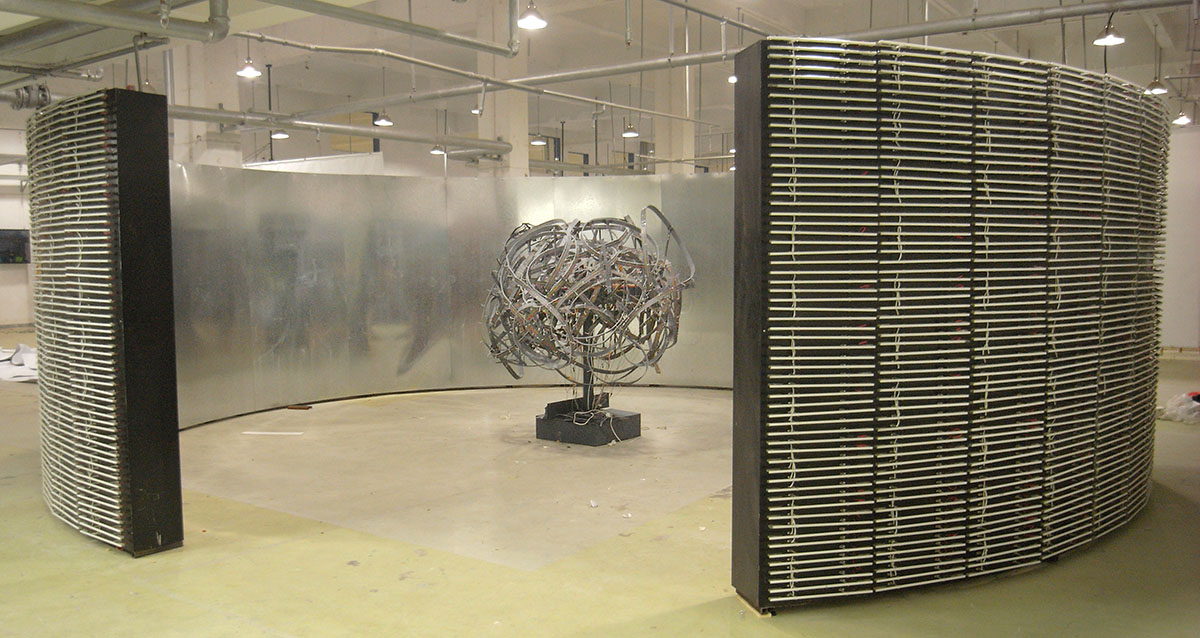BIENNALE SHENZHEN

---

Team: Neville Mars, Julia - Zhu Ming
Dream Wall is a neon-installation that displays an animation detailing how to streamline the Chinese city. Increasingly generic the Chinese city only relies on its neon lights to enhance its appearance. The energy consumption of the massive light walls along its skyline fly in the face of sustainability. China reveals that curbing consumption cannot be at the center of any carbon strategy. China will instead need to nurture green consumers.
Movie link: NEON DREAMS - outside
Movie link: NEON DREAMS and ROAD - compilation
INSIDE
the Chinese Dream in eight simple steps 中国梦, 八步走
The installation “The Chinese Dream in eight simple steps!” presents a comprehensive panorama of China’s dynamic urban landscape and offers a tongue in cheek Eight Steps Plan to improve it. The need to keep pace with progress is holding China and its designers in a tight grip to produce buildings, even entire cities in an instance. Four hundred new cities are needed in the next decade. Are there ways to escape the frenzy? In three storylines - the high-speed reality, the potential nightmare and the hope of a slow long-term dream - the DCF presents a roadmap to plan China for the year 2020.
THE CHINESE KNOT



The fast reality is introduced on a neon wall. A highly detailed panorama reveals itself on the inside. At the heart stands the sculpture "the Chinese Knot" which presents Beijing's 5 ring roads in a 2.4m large model, built at the exact same scale as the The Forbidden City hidden in its middle.
See Installation PDF: 8 STEPS background
8 STEPS
1. Faster / slower 快/ 慢
2. Rural / Urban 农村/ 城市
3. New city / Urban expansion 建新城/ 扩旧城
4. Top-down / Bottom-up 自上而下/自下而上
5. Big / small 大/小
6. Zoned / Mixed 分区/混杂
7. Roads / Tracks 路/轨
8. Scattered / Dense 分散/ 密集
Curatorial questions


1. What do we need and get from the city? Conversely, what do we provide for the city?
There is nothing but city. Over half the world’s population now lives in the city while those who remain in the countryside have become an inseparable part of the urban dynamic. The city has become the world’s refuge and must be treated as such. Only by understanding its inherent tendencies can we begin to streamline the urban landscape.
除了城市,无他。超过一半的世界人口目前在城市聚居,而农村人口也是城市的互动大图景中不可分割的部分。城市是世界的最终着落,而且必须如此加以对待。理解它与生俱来的品性将有助于我们引导城市发展的景观。
2. Can we trust our judgment of the future?
The city has proved to be incredibly consistent in its development — always years ahead of all our predictions and projections, particularly in China.
城市的发展呈现出惊人的一致性——它总是比人们的预期和猜测要快好几年,特别是在中国。
3. Should we invest in intelligence that maximizes a building's performance in a given time period or in sentiments which demand its perpetuation?
The fact is sentimental buildings in the West tend to last longer: all the more reason to make them intelligent!
在西方,让人动情的建筑往往更能持久——正是这些建筑应该被智能化的充分理由。

4. How can we maximize our needs today?
The city is straining under the array of conflicting needs the body of its users presents. We can only limit the scope of our urban desires.
城市已经在使用者需求的冲突中疲惫不堪。我们只能克制我们对城市的欲望。
5. Should buildings have expiration dates?
Buildings should have a designed life-cycle, not an expiration date.
建筑应该有被设计的生命周期,而不是保质期。
6. Should a city stay in its current form forever?
Both intentionally and unintentionally human activity will continue to change the city. The notion we can conform the city to a fixed state is falsehood. Therefor any attempt to do so will exacerbate the city’s development in unwanted directions.
人类的活动——无论是否有意识 ——都将持续改变着城市。所以任何保持城市形态固定的尝试都是徒劳。它们只能让城市朝人们不希望的方向偏离。
7. Can we envision a city composed of temporary buildings, instead of eternal monuments?
It’s easy to image a temporary city; Chinese cities have been treated as tabula rasa awaiting demolition for decades now. To replace this approach of urban slash-and-burn by intelligent design would require almost insurmountable economic and political effort. To promote ideas of a controlled life-cycle, the economic life-cycle of buildings and their management need to enter the argument.
要设想一个临时的城市很容易.中国的城市就是白纸上建立、几十年后将被摧毁来对待的。要以智能化的设计来取代刀耕火种的做法需要难以想象的经济及政治努力。如要推广被控制的生命周期的理念,建筑的经济生命周期和他们的管理都需要加入被论证的范畴。
8. What is the polar opposite to the city?
The countryside is spatially and economically no longer the converse of the city, only uninhabited space is.
城市的对立面不再是宽敞便宜的农村,而是无人居住地带。
9. What is the essence of agriculture?
Feeding the cities.
喂饱城里人。
10. Is agriculture the next form of urbanism?
不是, 但作为最为土地密集型的空间 – 密度是城市的40倍 - 农村也应该像城市一样被规划、被组织,并与城市密切关联或者位于城市之上方。No, but as the most space intensive form of land use - 40 times more than a city - it should be planned and orchestrated in ways similar to, in close conjunction with or right on top of the city.
This project was made possible with the support of the Embassy of the Kingdom of the Netherlands in Beijing

Owned by neville mars / Added by neville mars / 17.5 years ago / 170539 hits / 11 hours view time
Backlinks
Latest Entries
Contribute
Login to post an entry to this node.


















































